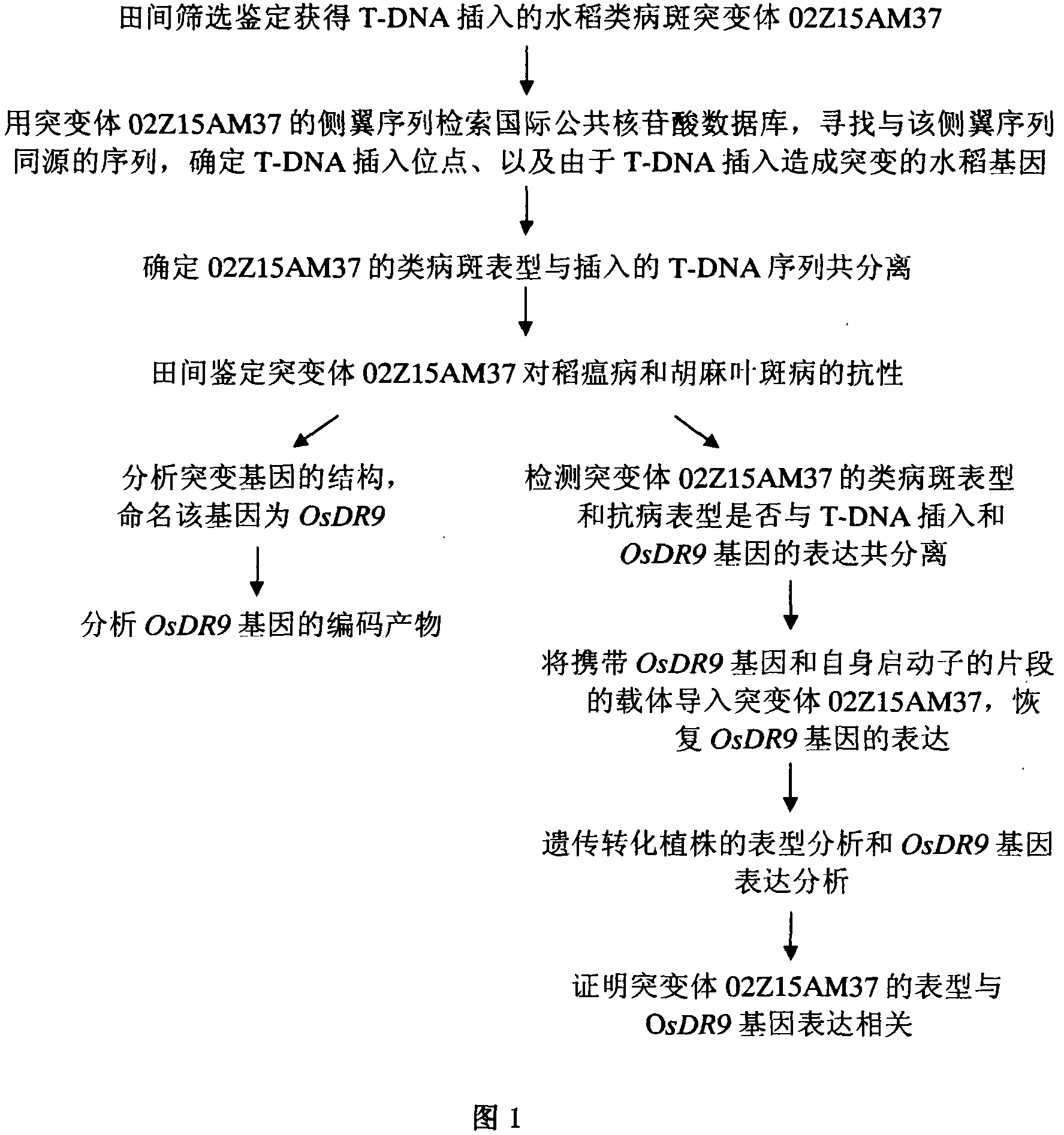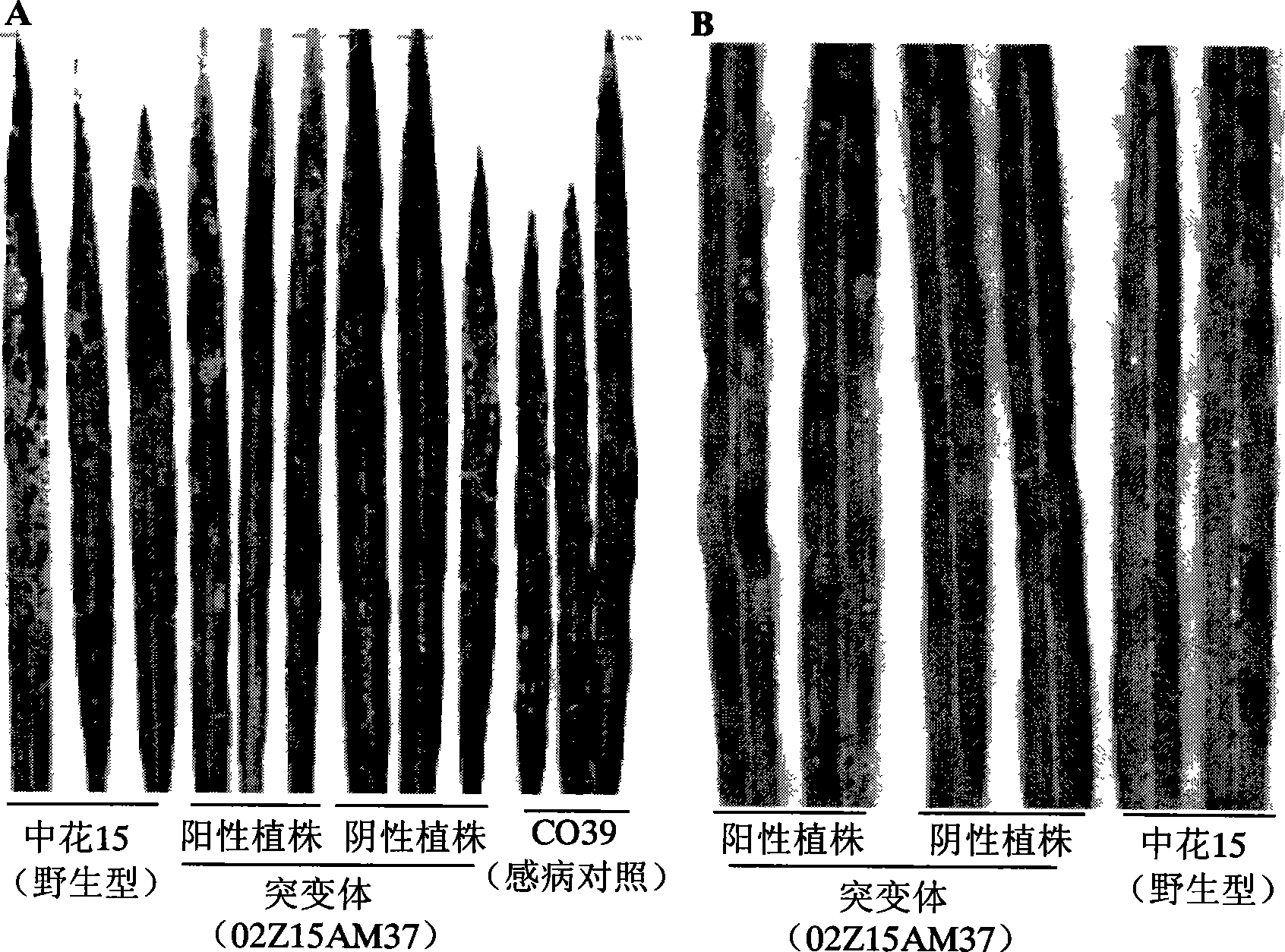Rice disease-resistant related gene OsDR9 and its use in improving rice disease resistance
A disease resistance, rice technology, applied in the field of plant genetic engineering, can solve the problems of decreased yield and quality, change of rice disease resistance phenotype, unclear and other problems
- Summary
- Abstract
- Description
- Claims
- Application Information
AI Technical Summary
Problems solved by technology
Method used
Image
Examples
Embodiment 1
[0023] Example 1: Identify rice disease-resistant lesion-like mutants and isolate and identify mutant genes
[0024] 1. Identification of Lesion-Like Mutants
[0025] Pathogens usually cause plant cell death at the site of infection after infecting plants, forming lesions (Agrios, 1988). Lesion mimics are lesions that resemble pathogenic infestation in the absence of pathogenic infestation. Studies have shown that some genes that cause rice plants to form lesion-like spots due to gene mutations may be disease resistance-related genes (Yamanouchi et al., 2002; Zeng et al., 2004; Mori et al., 2007; Yuan et al., 2007). Therefore, detection of plants that form lesion-like spots in the rice mutant library will help to identify new disease resistance-related genes. Huazhong Agricultural University, where the present invention belongs, created a rice T-DNA insertion mutant library containing about 129,000 independently transformed plants (Wu et al., 2003; Zhang et al., 2006), which l...
Embodiment 2
[0035] Example 2: Determining the OsDR9 gene structure and the relationship between lesion-like spots and OsDR9 gene expression
[0036] 1. OsDR9 gene structure analysis
[0037] Using GENSCAN (http: / / genes.mit.edu / GENSCAN.html), GeneFinder (http: / / genomic.sanger.ac.uk / gf / gf.shtml), Gene Feature Searches (http: / / dot.imgen .bem.tmc.edu: 9331 / ), GeneMark (http: / / genemark.biology.gatech.edu / GeneMark / hmmchoice.html) and other gene structure prediction software and BLAST analysis method (Altschul et al., 1997), Analyze and predict the structural features of the sequence homologous to the flanking sequence of the mutant 02Z15AM37 in a genome sequence AL662948 (section 2 in Example 1) derived from the rice variety Nipponbare and the sequences on both sides. Analysis results showed that in mutant 02Z15AM37, T-DNA was inserted into a predicted gene, which was named OsDR9 (Oryza sativa defense responsive 9) in the present invention.
[0038] The researchers of the present invention de...
Embodiment 3
[0042] Example 3: Verification of functional complementation of OsDR9 gene
[0043] The researchers of the present invention introduced the DNA fragment containing the OsDR9 gene and its own promoter into the mutant 02Z15AM37 by genetic transformation method. The genetic transformation vector used was pCAMBIA2301 (Fig. 7A). The pCAMBIA2301 vector is a series vector of the Agrobacterium-mediated genetic transformation vector pCAMBIA1301 (Sun et al., 2004) commonly used in the world, donated by CAMBIA Laboratory (Center for the Application of Molecular Biology to International Agriculture) in Australia.
[0044] Genetic transformation vectors were constructed using conventional recombinant plasmid construction methods (Sambrook and Russell, 2001). The main steps are: using restriction endonuclease digestion method, the BAC clone OSJNBa0060B20 of the rice variety Nipponbare containing the OsDR9 gene is digested with restriction endonucleases EcoRI and XbaI to obtain the OsDR9 ge...
PUM
 Login to View More
Login to View More Abstract
Description
Claims
Application Information
 Login to View More
Login to View More - R&D
- Intellectual Property
- Life Sciences
- Materials
- Tech Scout
- Unparalleled Data Quality
- Higher Quality Content
- 60% Fewer Hallucinations
Browse by: Latest US Patents, China's latest patents, Technical Efficacy Thesaurus, Application Domain, Technology Topic, Popular Technical Reports.
© 2025 PatSnap. All rights reserved.Legal|Privacy policy|Modern Slavery Act Transparency Statement|Sitemap|About US| Contact US: help@patsnap.com



